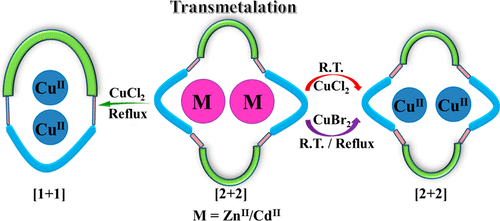当前位置:
X-MOL 学术
›
Inorg. Chem.
›
论文详情
Our official English website, www.x-mol.net, welcomes your feedback! (Note: you will need to create a separate account there.)
Transmetalation for Flexible Pendant-Armed Schiff-Base Macrocyclic Complexes Influenced by Halide Effects
Inorganic Chemistry ( IF 4.6 ) Pub Date : 2018-01-11 00:00:00 , DOI: 10.1021/acs.inorgchem.7b02835 Fei-Fan Chang 1 , Lei Zhang 1 , Pei-Chen Zhao 1 , Wei Huang 1
Inorganic Chemistry ( IF 4.6 ) Pub Date : 2018-01-11 00:00:00 , DOI: 10.1021/acs.inorgchem.7b02835 Fei-Fan Chang 1 , Lei Zhang 1 , Pei-Chen Zhao 1 , Wei Huang 1
Affiliation

|
Three 46-membered [2 + 2] pendant-armed Schiff-base macrocyclic dinuclear CdII and CuII complexes (2a, 2b, and 3b) and one 23-membered [1 + 1] CuII macrocycle 4a were prepared from the template-directed condensation reactions between 1,2-bis(2-aminoethoxy)-ethane and extended Cl-dialdehyde in the presence of CdX2 and CuX2 (X = Cl and Br), in which halide effects play important roles in the organization of final macrocyclic complexes in addition to the dominant influence of metal cations. Transmetalation was intensively studied among these CdII and CuII complexes with large and flexible macrocyclic ligands, including two previously synthesized dinuclear ZnII macrocycles (1a and 1b). Our results indicate that ZnII → CuII and CdII → CuII transmetalation proceeds more quickly than that from CdII to ZnII, and all the processes are found to be irreversible. It is noted that a [2 + 2] heterodinuclear CdIIZnII macrocyclic intermediate could be detected by ESI-MS together with [2 + 2] homodinuclear CdII and ZnII macrocyclic complexes. Furthermore, distinct halide behavior was observed in the in situ CdII → CuII and ZnII → CuII metal-ion exchange. That is to say, [2 + 2] macrocycles (1a and 2a) could be converted to [1 + 1] macrocycles 4a and 4b under the reflux condition in the case of CuCl2, accompanied by the configurational transformation from half-folded dinuclear ZnII and CdII to unfolded CuII macrocyclic skeleton. In contrast, CuBr2 leads to a highly efficient transmetalation to corresponding [2 + 2] dinuclear CuII complex 3b from both 1b and 2b no matter the experimental condition used.
中文翻译:

受卤化物影响的柔性链坠席夫基大环配合物的重金属化
从模板中制备了三个46元[2 + 2]悬臂臂席夫碱大环双核Cd II和Cu II配合物(2a,2b和3b)和一个23元[1 + 1] Cu II大环化合物4a。在CdX 2和CuX 2(X = Cl和Br)存在下,1,2-双(2-氨基乙氧基)-乙烷与扩展的Cl-二醛之间的直接缩合反应,其中卤化物效应在CdX 2的组织中起重要作用最终的大环配合物以及金属阳离子的主要影响。在这些Cd II和Cu II中对重金属化进行了深入研究配合物具有大而灵活的大环配体,包括两个先前合成的双核Zn II大环(1a和1b)。我们的结果表明,Zn II →Cu II和Cd II →Cu II的重金属化过程比从Cd II到Zn II的过程更快,并且发现所有过程都是不可逆的。值得注意的是,ESI-MS可以与[2 + 2]同核Cd II和Zn II一起检测到[2 + 2]异双核Cd II Zn II大环中间体。大环配合物。此外,在原位Cd II →Cu II和Zn II →Cu II金属离子交换中观察到明显的卤化物行为。也就是说,在CuCl 2的情况下,在回流条件下,[2 + 2]个大环(1a和2a)可以转化为[1 +1]个大环4a和4b,并伴随着半折叠双核的构型转化Zn II和Cd II形成未折叠的Cu II大环骨架。相反,CuBr 2无论使用何种实验条件,都可从1b和2b高效转化为相应的[2 + 2]双核Cu II配合物3b。
更新日期:2018-01-11
中文翻译:

受卤化物影响的柔性链坠席夫基大环配合物的重金属化
从模板中制备了三个46元[2 + 2]悬臂臂席夫碱大环双核Cd II和Cu II配合物(2a,2b和3b)和一个23元[1 + 1] Cu II大环化合物4a。在CdX 2和CuX 2(X = Cl和Br)存在下,1,2-双(2-氨基乙氧基)-乙烷与扩展的Cl-二醛之间的直接缩合反应,其中卤化物效应在CdX 2的组织中起重要作用最终的大环配合物以及金属阳离子的主要影响。在这些Cd II和Cu II中对重金属化进行了深入研究配合物具有大而灵活的大环配体,包括两个先前合成的双核Zn II大环(1a和1b)。我们的结果表明,Zn II →Cu II和Cd II →Cu II的重金属化过程比从Cd II到Zn II的过程更快,并且发现所有过程都是不可逆的。值得注意的是,ESI-MS可以与[2 + 2]同核Cd II和Zn II一起检测到[2 + 2]异双核Cd II Zn II大环中间体。大环配合物。此外,在原位Cd II →Cu II和Zn II →Cu II金属离子交换中观察到明显的卤化物行为。也就是说,在CuCl 2的情况下,在回流条件下,[2 + 2]个大环(1a和2a)可以转化为[1 +1]个大环4a和4b,并伴随着半折叠双核的构型转化Zn II和Cd II形成未折叠的Cu II大环骨架。相反,CuBr 2无论使用何种实验条件,都可从1b和2b高效转化为相应的[2 + 2]双核Cu II配合物3b。



























 京公网安备 11010802027423号
京公网安备 11010802027423号